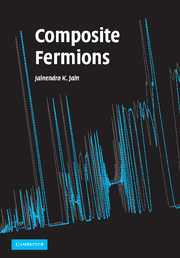Book contents
- Frontmatter
- Contents
- Preface
- List of symbols and abbreviations
- 1 Overview
- 2 Quantum Hall effect
- 3 Landau levels
- 4 Theory of the IQHE
- 5 Foundations of the composite fermion theory
- 6 Microscopic verifications
- 7 Theory of the FQHE
- 8 Incompressible ground states and their excitations
- 9 Topology and quantizations
- 10 Composite fermion Fermi sea
- 11 Composite fermions with spin
- 12 Non-composite fermion approaches
- 13 Bilayer FQHE
- 14 Edge physics
- 15 Composite fermion crystals
- Appendixes
- References
- Index
5 - Foundations of the composite fermion theory
Published online by Cambridge University Press: 07 December 2009
- Frontmatter
- Contents
- Preface
- List of symbols and abbreviations
- 1 Overview
- 2 Quantum Hall effect
- 3 Landau levels
- 4 Theory of the IQHE
- 5 Foundations of the composite fermion theory
- 6 Microscopic verifications
- 7 Theory of the FQHE
- 8 Incompressible ground states and their excitations
- 9 Topology and quantizations
- 10 Composite fermion Fermi sea
- 11 Composite fermions with spin
- 12 Non-composite fermion approaches
- 13 Bilayer FQHE
- 14 Edge physics
- 15 Composite fermion crystals
- Appendixes
- References
- Index
Summary
This chapter introduces the basic principles of the composite fermion theory. It should really be called the “composite fermion model” or the “composite fermion hypothesis” in this chapter. The extensive scrutiny and testing that elevate it to the status of a “theory” are topics of subsequent chapters.
The great FQHE mystery
Not often does nature present us with a mystery as well defined as the phenomenon of the fractional quantum Hall effect. The questions that theory is challenged to answer could not be more sharply posed.
What is the physics of this quantum fluid? The appearance of precise quantum numbers and dissipationless transport in a dirty solid state system containing many electrons is a signature of cooperative behavior. What are the correlations in the FQHE state and why do they manifest themselves in such a rich, yet stunningly simple fashion? Why do gaps open at certain fractional fillings of the lowest Landau level? Experiments point to something unique and special about ground states at certain special filling factors. What order brings about this uniqueness?
A tremendous amount of factual information is contained in the fractions that are observed and the order in which they appear. That imposes rigorous constraints on theory. With the proliferation of fractions, certain striking patterns have emerged. Many fractions are conspicuous by their absence. For example, the simplest fraction f = 1/2 has not been observed. In fact, no sub-unity fractions with even denominators have been observed. Another remarkable aspect is that fractions are not isolated but belong to certain sequences. For example, in Fig. 2.7, the fractions 1/3, 2/5, 3/7, 4/9, 5/11, … follow the sequence f = n/(2n+1). These observations lead to the following questions: Why are some fractions seen but not others? Why do they appear in sequences?
[…]
Information
- Type
- Chapter
- Information
- Composite Fermions , pp. 105 - 173Publisher: Cambridge University PressPrint publication year: 2007
Accessibility standard: Unknown
- 1
- Cited by
